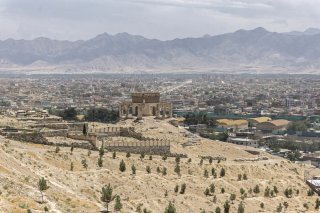Video: Afghanistan and Central Asia Since the Taliban Takeover
The shockwaves of the August 2021 U.S. withdrawal from Afghanistan and subsequent Taliban takeover have reverberated across Central Asia—and now Russia.
<p>The <a href="https://nationalinterest.org/feature/podcast-terror-moscow-and-putin%E2%... attack</a> at Moscow’s Crocus City Hall last Friday—which left more than 130 dead—serves as a tragic reminder of the global risks presented by terrorist groups emerging in Afghanistan and throughout the Greater Middle East. The group ISIS-K has claimed credit for the attack, and Russian authorities have so far arraigned three suspects from Tajikistan and a fourth also from Central Asia. The United States lacks leverage to contain cross-border incursions and terrorist acts emanating from the region, and Russia’s capabilities as a security provider in Central Asia have also diminished since its full-scale invasion of Ukraine in 2022. Compounding these security concerns is a lack of cross-border cooperation. In the water-scarce region, Taliban efforts to build the long-desired Qosh Tepa Canal on the Amu Darya River and a water diversion project on the Helmand River have strained relations with downstream Central Asian states and Iran. The combination of weak states, the presence of terrorist and insurgent groups, and pervasive water shortages all present major challenges to regional stability. The Center for the National Interest hosted the second in a monthly series of expert discussions organized by the Center’s Central Asia Connectivity Project.</p>
<iframe allow="accelerometer; autoplay; clipboard-write; encrypted-media; gyroscope; picture-in-picture; web-share" allowfullscreen="" frameborder="0" height="315" src="https://www.youtube.com/embed/8h2uodwHzso" title="YouTube video player" width="560"></iframe>
<p>—<a href="https://www.linkedin.com/in/zekria-barakzai-5b274385/"><strong>Zekria Barakzai</strong></a> is a former top diplomat with more than 30 years of experience working across the private sector, international organizations, NGOs, and the Afghan government. He received his MA in International Relations from Moscow State University for International Relations (MGIMO) and is currently a PhD researcher in International Affairs at Altinbas University in Istanbul, Turkey. His research focuses on Afghanistan’s transboundary water issues and water diplomacy.</p>
<p>—<a href="https://www.cgm.pitt.edu/people/jennifer-murtazashvili"><strong>Jennifer Brick Murtazashvili</strong></a> is the Founding Director of the Center for Governance and Markets and Professor of Public and International Affairs at the University of Pittsburgh. She has more than 25 years of experience working, conducting research, and living across Central Eurasia. She is the author of two books on Afghanistan and has advised the World Bank, USAID, and countless others. She is a contributing editor at National Interest magazine and was named by Prospect magazine as one of the world’s top thinkers.</p>
<p>—<a href="https://tomsandersonconsulting.com/"><strong>Tom Sanderson</strong></a> is Principal at Tom Sanderson Consulting where he leads a team serving clients on geopolitics, terrorism, and frontier markets. He is the former director of the Transnational Threats Project at CSIS. Across 25 years of fieldwork, Sanderson has produced dozens of CSIS reports, published in The New York Times and Washington Post, testified before the U.S. Congress, provided expert commentary for the media, and taught courses for the U.S. Intelligence Community. He advises the Middle East Institute, Atlantic Council, and Hostage US. Recent fieldwork includes Ukraine, Georgia, Taiwan, Jordan, Tajikistan, and Uzbekistan.</p>
<p><strong><a href="https://cftni.org/expert/andrew-c-kuchins/">Andrew Kuchins</a></strong>, Senior Fellow at the Center for the National Interest, moderated the discussion.</p>
<p><em>Image: Shutterstock.com. </em></p>

